Explainer
- Explainer
- Coronavirus pandemic
How does an epidemic spread and what does the wildlife trade have to do with it?
It's worth billions of dollars to organised crime – after guns, drugs and human trafficking. But why is the illegal wildlife trade at the centre of the coronavirus epidemic?
There was a dead lizard in the mail. But that wasn’t the unusual part. Australia’s wildlife “coroner”, forensic veterinary pathologist Dr Lydia Tong, performs hundreds of autopsies on native and exotic animals each year, many of them from zoos; others, such as this shingleback lizard, the victim of a multibillion-dollar global trade gone wrong.
This time the reptile had its own unusual traveller – a parasite never before seen in a shingleback.
“Straight away that was a clue that it might have been handled with another species, maybe there had been a jump,” Tong says. “It’s hard to say but that’s why we monitor and investigate these kinds of infections so closely with wildlife. The trade is a melting pot for it."
From live monkeys smuggled through customs to tigers shot or bred for their bones, soaring demand for wildlife, dead or alive, has spawned the world’s fourth-largest contraband market - right behind drugs, humans and guns. Gram for gram, rhino horn and endangered turtles are now worth more than cocaine. But experts warn the world's latest coronavirus outbreak shows the trade threatens more than just animals.
As people push farther and farther into the last wild places, more diseases previously unknown to humanity are making the leap across species lines. Vet and epidemiologist Dr Jon Epstein says habitat loss, global travel and a persistent appetite for wild animals have created a “perfect storm” for the next human pandemic. And Asia's infamous wet markets – where both the deadly 2003 SARS outbreak and now the latest coronavirus COVID-19 are thought to have started – remain ground zero. Early research suggests the world's most illegally trafficked animal - the endangered pangolin - could be the very species that passed on this new virus to humans.
So how do these diseases spread, why are people still buying wildlife and what is being done to stop the next animal-borne epidemic?
Warning: distressing content.
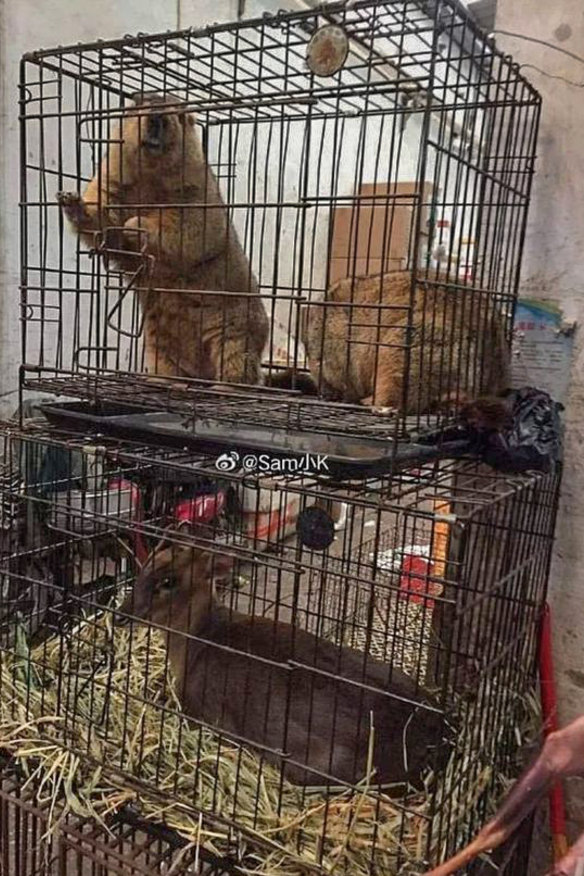
An image of a bamboo rat caged on top of a deer allegedly sold at the Wuhan seafood market has circulated online. Credit: Weibo
Where did the coronavirus come from?
In the Chinese city of Wuhan, the sickness seemed to come from the western end of the seafood market – where the fare on offer wasn't only taken from the sea. As China began to realise just what had stirred inside its borders, a team of forensic medical experts descended on the market. They found traces of the mystery virus in areas where traders reportedly sold wild animals: porcupines, raccoon dogs, foxes, bamboo rats, frogs and more, all caged together for slaughter in the rush and press of the market. Some of those traders ended up in hospital with strange fevers and pneumonia. Close to 2 million cases of COVID-19 have been confirmed worldwide since December.
Not all of those initial patients reported contact with the market. But while Chinese researchers so far have claimed they are yet to find the source species, they have already ruled that the illegal wildlife trade is involved.
"It looks like there was transmission in the market," Epstein says. "But where the virus actually came from, which animal, that's still a mystery, that's still the black box."
By New Year's Day, the entire market had been shuttered under quarantine in scenes eerily reminiscent of the SARS crisis. For scientists such as Epstein, who have been monitoring wild diseases ever since, it wasn't a surprise.
How do animal viruses get into humans?
More than 70 per cent of all new diseases emerging in humans are thought to have been caught from animals, some of which, such as bats, primates and rodents, might have lived with the viruses for thousands of years. Bats are essential to many ecosystems we rely on but, through a lucky quirk in their immune system, they also carry a whole host of diseases that do not harm them. As animals come into contact with each other, the viruses that have grown up with one species have a chance to jump to something new. Often it is the new host's reaction to these tiny invaders that causes illness. And as viruses copy and mutate in unfamiliar environments, they can also become more unstable.
Experts warn such diseases are now making the jump to humans more often and spreading farther as the global trade in exotic wildlife – sold for their meat, parts and as exotic pets – ramps up.
Every day in Asia, scores of live animals are trucked into markets for slaughter from all corners of the region as part of a longstanding cultural preference for fresh meat over frozen. Some of them have been caught from the wild, sold on from remote or poorer communities to vendors or smugglers, both legally and as part of a thriving global trade in "wild tastes" and exotic products. More than 5500 of the 31,500 known vertebrate species on Earth are now traded and another 3196 are at risk as similar species dwindle in the wild.
But as well as driving extinction, the trade puts unfamiliar animals on a collision course with each other. Increasingly, endangered species are taken from more exotic locales in Africa, South America and even Scandinavia and then thrust close together in cages.
"These markets [and cages] are often really dirty and cramped, you might have bats on top of rabbits on top of rodents," Epstein says. "They're stressed out, trading body fluids, there's faecal matter, blood. That's the perfect opportunity for a virus [to] jump."
Update: China's response backflips
Since this article was first published on February 7, China has taken conflicting steps on the wildlife trade. Under fire for keeping much of the trade legal after SARS, Beijing had in February announced seismic reforms to outlaw the sale of all wildlife for food and restrict their commerce for medicine, pets or research. Shenzhen also recently became the first Chinese city to ban the sale and consumption of dogs and cats, millions of which are also sold in wet markets for meat every year. But by April, China was offering tax breaks to ship wildlife products overseas (a perk not extended to medical supplies) and reopening wet markets back home - a move slammed as unfathomable by Australia's Prime Minister Scott Morrison given what is known about the market's risks to human health. The World Health Organisation has warned against wet markets but stopped short of condemning China's decision, noting it cannot police countries, it can only advise them and its advice is to shut the markets down. Beijing had initially blamed the wildlife trade for the outbreak, but its Foreign Ministry spokesman Lijian Zhao has since ignored research showing the natural origins of the virus in favour of unfounded conspiracy theories about where it came from. China's national health commission has even advised that unproven traditional remedies including bear bile can help patients critically ill with COVID-19.
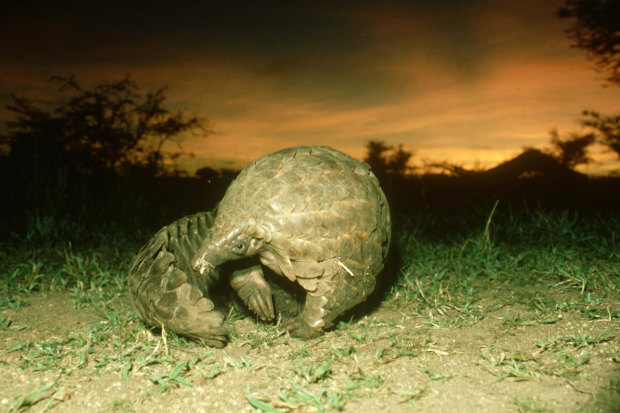
The endangered pangolin now carries the auspicious title of the world's most illegally trafficked animal amid demand for its scales and meat in cuisine and traditional medicine.Credit: Getty Images
It's what biologist Professor Diana Bell calls "the speed-dating of diseases", where animals under intense stress shed their viruses faster and have fewer immune defences against new ones. The killing is often bloody, done by hand with knives in the middle of the market, amplifying the risk to humans. If a vendor already has a cut on their hand or touches their nose or mouth, they can be infected. Coronaviruses can also be passed on by rodents like bamboo rats, commonly sold in wet markets, Bell says.
At Traffic, an international group that monitors the wildlife trade, Dr Richard Thomas says it is still unclear if the Wuhan wet market was the source of the latest outbreak, but conditions in such places are a "recipe for disaster".
What are wild animals traded for besides food?
Elephants are killed for their valuable ivory. Species, such as the endangered rhino and tiger, are prized for the unproven medicinal value of their bones or parts. Bears are caged and "milked" for the bile of their gall bladder, smaller mammals like foxes bred for their fur; the skins of predators like lions and polar bears become trophies or their young are smuggled overseas live as pets. Monkeys are even caught in the wilds of Southeast Asia for live sale to Western research labs. In one extraordinary case in 1997, a long-tailed macaque bound for the US escaped from its crate on a flight stopover in Paris and caused chaos on the tarmac.
Scientists poring over the virus's genome say it is about 75 per cent similiar to the original SARS strain but have found a closer (96%) match to another coronavirus already found in bats, which are still eaten throughout some parts of Asia. As bat viruses tend to be very stable, many experts expect another mammal likely served as "the missing link" between bats and humans, as was the case with viruses such as SARS and Hendra. Once the virus jumped from a bat to a new host species, it mutated and grew in potency before leaping again into humans.
More than one paper has since found an even closer match for the new virus in pangolins. While studies have so far been based off samples from pangolins taken elsewhere in China over the past year, experts are nonetheless intrigued by the theory, given the widespread trade of the mammal for its meat and scales. (An an earlier report linking the virus to snakes has already been widely dismissed by experts, who say such diseases are unlikely to jump from reptiles to humans.)
But they can spread swiftly in the exotic pet trade as well as wet markets, Tong notes, as animals are again thrown together and transported great distances. At the Australian Museum, wildlife forensic scientist Dr Greta Frankham helps run DNA tests and gather evidence for local police and border officials prosecuting wildlife crime. She says the trade carries a huge biosecurity risk.
"In recent cases we've seen native and exotic species held together in the same rooms, so it's always possible things could jump," she says. "Even pets coming in, we've had cases of them turning up abandoned, they could pass something on to our native wildlife. It'd only take one bird with Newcastle disease to devastate the agriculture industry."

Less than 4000 tigers remain in the wild but at least 100 are still killed each year for the global trade in their parts and skin. Credit: Getty Images
Were there signs this would happen?
Yes, and warnings from scientists. Epstein has been to the wet market in Guangzhou where SARS emerged. At least two species there tested positive for the virus: raccoon dogs and civets, a cat-like mammal served as a delicacy in Asia. Thousands were seized and killed by Chinese officials at the height of the crisis. But two years later, Epstein was part of the team that eventually traced the virus back to another wild animal in China - bats.
"Some researchers think it could even have been passed directly to humans by bats in the market, and then poor civets caught it from us," Epstein says.
Since then bats have been implicated in ongoing outbreaks of the deadly Ebola virus in Africa, sometimes directly or via infected gorilla carcasses brought back from the jungle, and in the case of the coronavirus MERS (Middle East Respiratory Syndrome), through camels. Disease hunters such as Epstein, along with researchers at the Wuhan Institute of Virology, have continued to monitor wild bat populations for the past 15 years through the group EcoHealth Alliance.
Since 2013, they've found a whole reservoir of SARS-like viruses in bats in the caves of Yunnan province, more than a thousand kilometres from Wuhan. Villagers living nearby had survived the SARS scare of 2003 unscathed and yet tests revealed their bodies had been making antibodies against a bat coronavirus all the same. The reason? Scientists suspect they had already been exposed to a virus, at least in small doses, through hunting and eating bats, though no disease had broken out among them.
“Exposure is already happening,” Epstein says. "We don’t know how much it takes to make you sick but we’ve been warning about this for a while. It's going to be so much more costly by the time we're done dealing with this outbreak than if we'd just prevented it.”
One of the viruses from those bat caves is now the closest known genetic relative of the strain behind COVID-19.

This lion cub was one of 30 big cats seized by police during coordinated raids on traffickers across the world in June 2019.Credit: Interpol
What is being done about the wildlife trade?
During the panic of SARS, a temporary ban on the wildlife trade came into force across China, as it has again during COVID-19. But it lifted the ban within months, saying animals could instead be bred in farms subject to sanitation checks. More than 50 wild species can still be legally traded throughout China - and other parts of the world - including badgers, Arctic foxes, crocodiles and even civets and bats. While eating bats was widely outlawed across Africa following the Ebola crisis, caves are still raided by hunters in Asia to feed the market, although eating bat has become increasingly taboo among Chinese since 2003.
For organised crime, the trade in protected species is an enticing slice of the black market - worth at least $22 billion each year globally but still largely under-policed. And demand is growing fast alongside middle-class wealth in developing Asian countries. The main corridor of trade, South-east Asia, includes China, Indonesia, Vietnam, Laos and Myanmar, with China still the biggest market, having outlawed the consumption of protected species only in recent years. But US and Europe are also booming.
China has banned ivory but continues to allow commercial farming of certain animals for their parts, including the critically endangered tiger. The rush to to shut down breeding farms in the wake of the coronavirus outbreak has began to expose the staggering scale of the secretive industry - more than 19,000 farms have reportedly been put under quarantine across the country. Meanwhile groups that monitor wild animal sales report restaurants often broker secret deals with poachers and middlemen. In markets, sometimes it’s simply a case of keeping wildlife hidden out back or selling after dark.
Even beyond Asia, experts say most regulation is still weak and slow to respond to shifts on the ground, such as new gaps emerging for British wildlife amid Brexit. And Tong warns the poachers are getting bolder. In 2017 a group walked into a French zoo, shot dead a beloved four-year-old rhino named Vince and walked out with his horn. No one has been arrested over the crime.
Interpol says police are stepping up their work with border officials in response. In June 2019, a series of carefully choreographed raids on traffickers around the world seized $5 million worth of animals, products and illegal timber, including 23 live primates, 30 big cats and nearly 10,000 live turtles.
But some animals still only have partial protection - they can’t be taken from the wild but they can be bred for sale. That’s allowed organised crime to largely expand the trade in plain sight through “wildlife laundering”, passing off animals caught in the wild as captive-bred.
“It’s cheaper to take from the wild,” Tong says. “[Authorities] often tell us their hands are tied because they have no real way of proving the paperwork is a fraud in court. The whole thing almost relies on an honour system.”
The pathologist has now joined forces with a “ragtag” group of Australian researchers - from nuclear technologists to animal nutritionists and experts in machine learning - to devise faster, “Border Force-ready” modes of detecting when wild-caught animals are imported.
“We’re sort of like the wildlife Avengers,” Tong laughs. “We’ve trialled it already on echidna spines because we think wild echidnas are laundered out of New Guinea, and [the test we developed] could show a difference between our echidnas in the zoo and those in the wild more than 99 per cent of the time.”
After the success of that trial, the team is hoping to develop a similar test for pangolin scales, which are trafficked by the tonne across the globe.

One snow leopard is killed each day, on average, to feed demand for their parts, often as trophies.Credit: Getty Images
How are Australian wildlife caught up in the trade?
Echidnas are not routinely snatched from the wild, Tong says, but there is a worrying market for Australian animals overseas as pets, bigger in the US and Europe even than in Asia.
"They're cute, they're really rare," she says. "Reptiles will turn up in the post. Or with animals like an echidna they might be a private zoo thinking they're getting an animal legally."
The Department of Agriculture and Environment says Australia's unique wildlife is highly sought after abroad as pets and has been reported in Asia, Europe and North America.
Recent police investigations have revealed deep links between Australia and overseas trafficking syndicates and there are currently six matters before NSW courts. Data since 2017 shows Border Force has made about 500 seizures of illegal wildlife products a year, including turtle shells, ivory and animal skins, most of them imports. There's even a macabre collection still enduring beneath the department's Canberra offices, a "dead shed" of polar bear rugs, lion's paw "gloves" and orangutan skulls, all seized on Australian soil.
But last financial year the number of live animals the force seized tripled from 112 in 2017-18 to 352 in 2018-19, driven mostly by a sudden surge in reptiles.
Unlike human forensics, the science of wildlife crime has a great deal of uncharted ground – and species – to cover, Frankham says, but the recent high-profile bust of a smuggling ring run out of Australia by ex-NRL star Martin Kennedy has helped set the tone for tougher prosecutions. Kennedy was jailed for four years last October for a range of offences, including smuggling stingrays and snapping turtles from Thailand and exporting native lizards to Sweden. Even sugar gliders were caught up in the plot, which was thrawted by an undercover police sting.
A government spokesman stressed stopping wildlife crime was a priority, and Australia now has some of the toughest penalties in the world – up to 10 years' jail and $210,000 in fines.
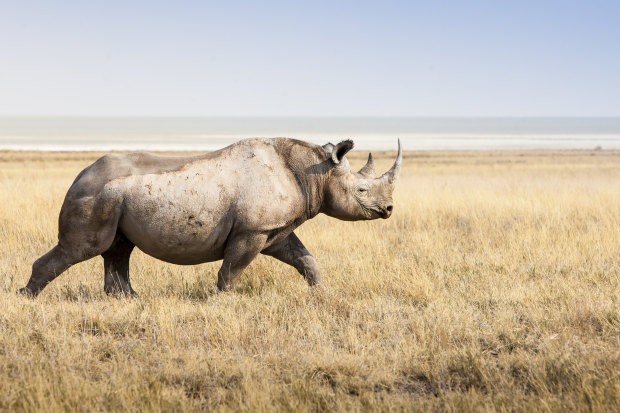
A thousand rhinos are killed each year for their horns, which are touted as a cure-all for everything from cancer to hangovers.Credit: Getty Images
Are wildlife products and meat still popular in China?
The cultural significance placed on consuming certain species and their parts for Traditional Chinese Medicine remains strong in some regions, though science has not found any medicinal benefit. In winter, amid Lunar New Year celebrations and feasts, demand for exotic tastes peaks and wildlife stalls grow. But surveys have found appetites for game meat are waning among younger generations. Some experts have urged caution about the myth of the Asian superconsumer, noting the market can vary greatly from one city to another.
Bell notes that unlike Africa, where wild animals are hunted in lieu of other available livestock, in China wild meat is now typically more expensive to buy and so not driven by poverty. Other products such as tiger bone and rhino horn are increasingly sold as status symbols or cures for everything from cancer to hangovers, despite awareness campaigns featuring celebrities and business leaders to combat the practice.
At the Zoological Society of London, Professor Andrew Cunningham says bats are still widely harvested for food - in fact the numbers hunted may even be on the rise as other mammals die out.
What did the Wuhan market sell?
A photo of a menu that appeared to have been posted to a Chinese review app by a vendor at the market quickly circulated online as the virus spread. At “Wild Game Livestock for the Masses” more than 110 species including civets, bamboo rats, foxes and hedgehogs were listed for sale. Experts say this is typical for such markets and there have also been unconfirmed reports of illegal sales at the market, such as of endangered pangolins. Court records reveal that authorities in Hubei province, of which Wuhan is the capital, investigated 250 cases related to wildlife trafficking and poaching last year. Since 2018 an estimated 16,000 wild animals have been hunted in the province of more than 60 million people, local media has reported.
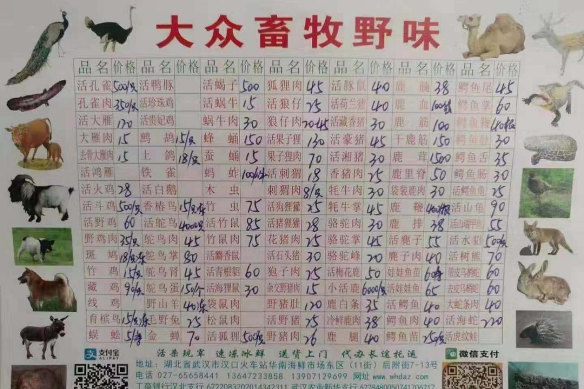
The price list posted by a vendor on a Chinese review app showed more than 100 wildlife species for sale at the now-closed Wuhan Seafood Market.Credit: Twitter
How likely is a permanent end to the legal wildlife trade?
As COVID-19 began its march across China and the world, petitions calling for a ban on wild meat circulated on the Chinese internet, at first seemingly without government censorship. State media outlets likewise published scathing editorials calling for a permanent ban, as the Chinese government faced uncomfortable questions about why it hadn't learn the lesson of SARS.
“This incident should be used as an opportunity to rectify the chaos” in China’s wildlife trade, said a petition by 19 prominent Chinese scientists, including employees of the Wuhan Institute of Virology. It is not animals such as bats which are the problem but human activity, they argued.
Bell was among the scientists calling for a ban on wet markets and the wildlife trade in 2004, as the world recovered from the first big coronavirus outbreak. "We have to hope that Wuhan is a wake-up call," she says.
On February 24, it appeared Chinese President Xi Jinping had listened. An announcement came from the government that the temporary ban on wildlife trade would be extended into legislation - outlawing the sale of wild animals for food and putting stricter controls on the trade for medicine, pets and scientific research.
Wildlife advocates welcomed the move, even as they raised concerns about the potential "panic culling" of wildlife like pangolins and civet cats or hedgehogs under quarantine. Some stress the legal trade in endangered animal parts for medicine should also be outlawed, with the legislation needing to focus on conservation.
Epstein says that, while an end to the trade is critical, it will be difficult to enforce an outright ban.
"It will just drive it more underground than it already is," he says. "The people running the [illegal side of] the trade globally are the same people running drugs and [human trafficking]. The demand's got to stop too. It's a market. And people have to stop buying."
Breaking the trade's hold in China will not be easy - along with longstanding traditions, the country has a staggering amount of money tied up in the market as the world's biggest producer and consumer of wildlife products.
Now advocates see red flags that the history of SARS may be about to repeat itself - China has announced tax breaks on wildlife products shipped overseas and is reopening wet markets as lockdowns on the first known site of the virus, Wuhan, lift. The World Health Organisation has so far refused to condemn the markets reopening, which Australia has already slammed as "unfathomable". But WHO special envoy and UN representative Dr David Nabarro told the BBC that the health authority's advice to China would be to close the markets, even though it had no power to police countries. He said the WHO “pleads with governments and just about everybody” to be respectful of how viruses from the animal kingdom emerge.
The solution, experts such as Epstein, Bell and Cunningham say, is getting ahead of outbreaks, monitoring viruses circulating in likely carrier animals such as bats and rethinking our riskier interactions with wildlife (including butchering them or forcing them into populated areas by clearing forests). Until then, the twin forces of resource consumption and globalisation will continue to leave the world wide open to pandemics of this kind.
It's people, not animals that need to change.
Sign up to our Coronavirus Update newsletter
With AP
This article was originally published on February 7 and has been updated to reflect new research and developments.
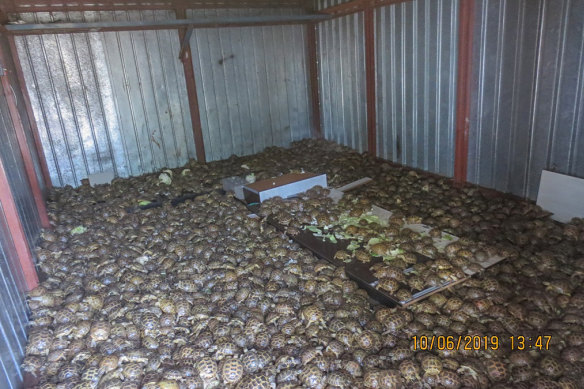
Police seized thousands of live turtles during a series of raids on traffickers around the world last June. Credit: Interpol
Let us explain
If you'd like some expert background on an issue or a news event, drop us a line at explainers@smh.com.au or explainers@theage.com.au. Read more explainers here.